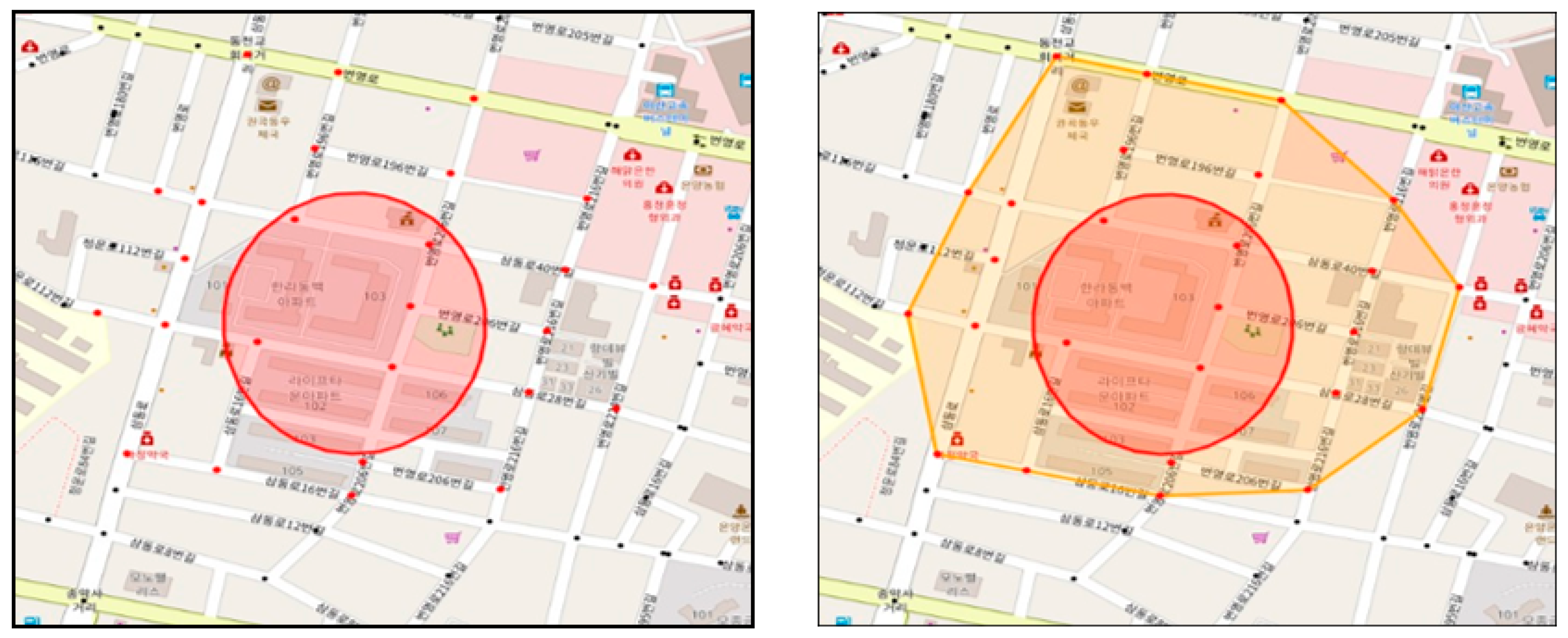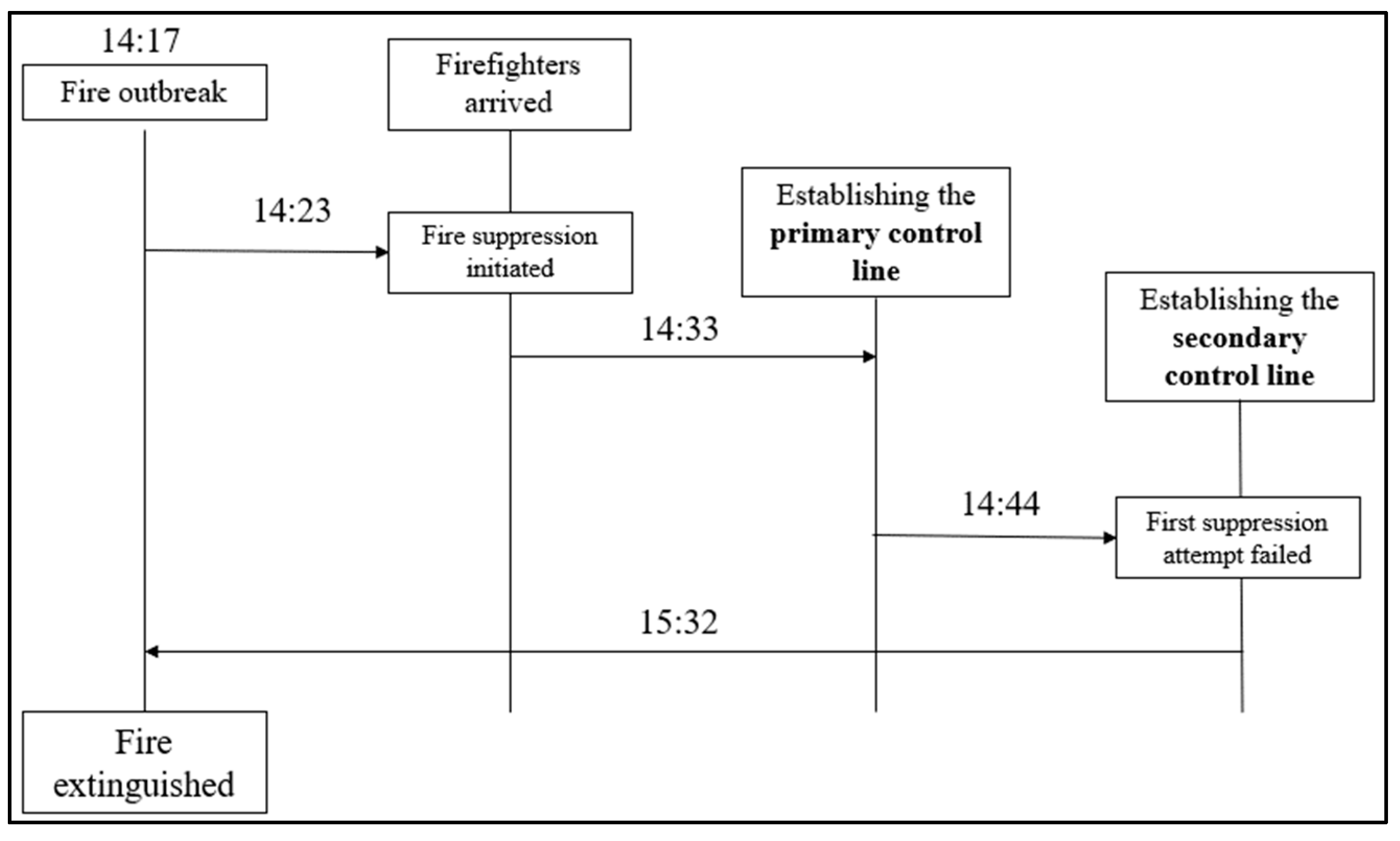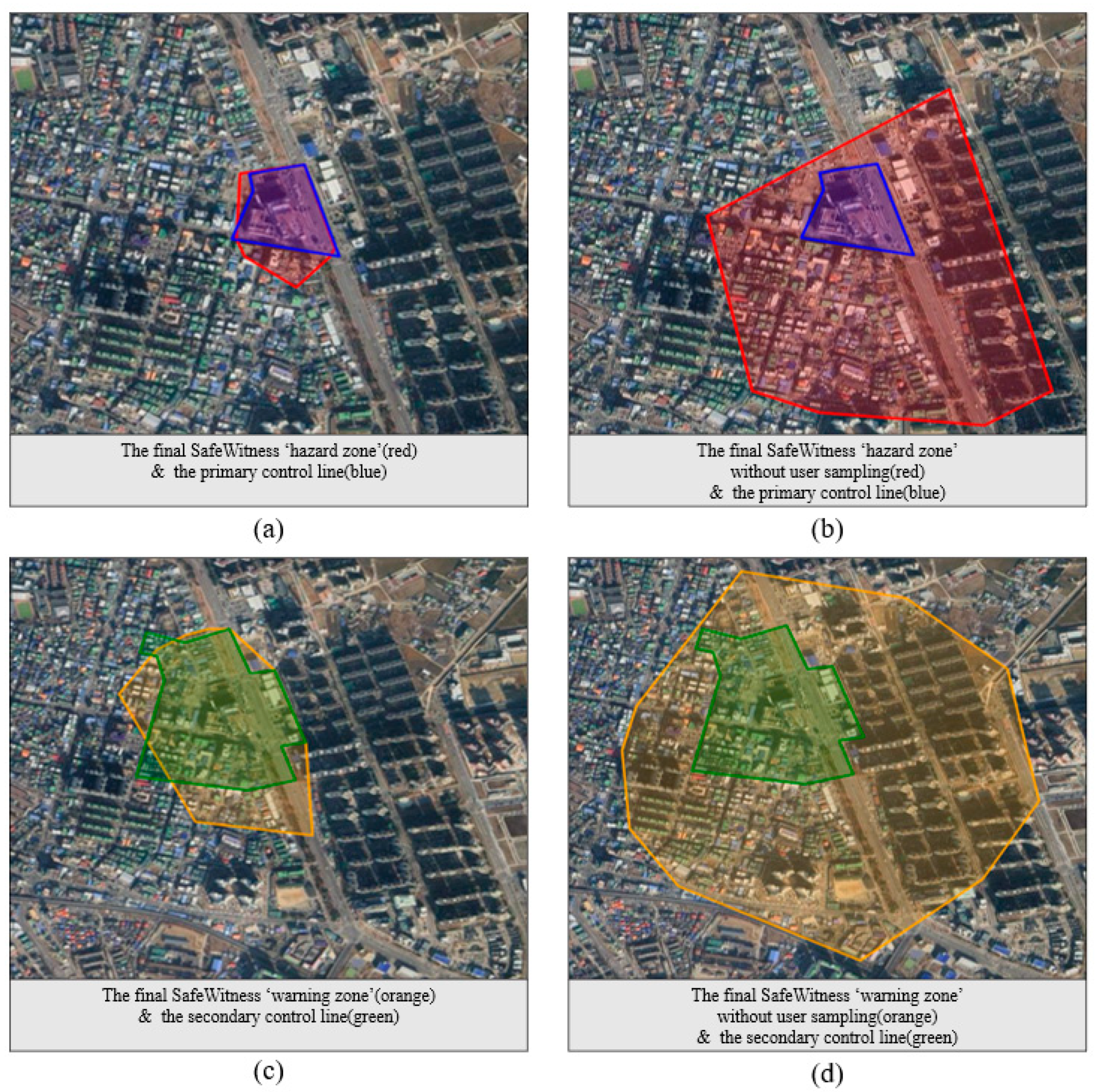SafeWitness: Crowdsensing-Based Geofencing Approach for Dynamic Disaster Risk Detection
Abstract
1. Introduction
- How can crowdsensing-based geofencing be effectively integrated to dynamically model disaster risk areas?
- How can fractal analysis improve disaster risk detection by modeling the self-similar?
- How can SafeWitness optimize geofencing expansion control?
2. Related Work
3. Proposed Methodology
3.1. Overview
3.2. Generalization of GIS Road Information
3.3. Initialization of SafeWitness
3.4. Crowdsensing-Based SafeWitness
3.4.1. User Information Sampling (Candidates)
3.4.2. User Information Sampling (Participants)
3.4.3. Dynamic SafeWitness
4. Experiments
4.1. Scenario: Major Fire in a Complex Facility
4.2. Implementation
4.3. Experimental Analysis
4.4. Discussion
5. Conclusions
Author Contributions
Funding
Data Availability Statement
Conflicts of Interest
References
- Alexander, D.E. Principles of Emergency Planning and Management; Oxford University Press: Oxford, UK, 2002; ISBN 0195218388. [Google Scholar]
- Aulov, O.; Halem, M. Human Sensor Networks for Improved Modeling of Natural Disasters. Proc. IEEE 2012, 100, 2812–2823. [Google Scholar] [CrossRef]
- Noji, E.K. The Public Health Consequences of Disasters. Prehosp. Disaster Med. 2000, 15, 21–31. [Google Scholar] [CrossRef]
- Rodríguez, H.; Quarantelli, E.L.; Dynes, R.R.; Quarantelli, E.L.; Lagadec, P.; Boin, A. A Heuristic Approach to Future Disasters and Crises: New, Old, and in-between Types. In Handbook of Disaster Research; Springer: New York, NY, USA, 2007; pp. 16–41. [Google Scholar]
- Besaleva, L.I.; Weaver, A.C. Applications of Social Networks and Crowdsourcing for Disaster Management Improvement. In Proceedings of the 2013 International Conference on Social Computing, Washington, DC, USA, 8–14 September 2013; IEEE: Piscataway, NJ, USA, 2013; pp. 213–219. [Google Scholar]
- Sajjad, M.; Chan, J.C.L.; Chopra, S.S. Rethinking Disaster Resilience in High-Density Cities: Towards an Urban Resilience Knowledge System. Sustain. Cities Soc. 2021, 69, 102850. [Google Scholar] [CrossRef]
- Alazawi, Z.; Alani, O.; Abdljabar, M.B.; Altowaijri, S.; Mehmood, R. A Smart Disaster Management System for Future Cities. In Proceedings of the 2014 ACM International Workshop on Wireless and Mobile Technologies for Smart Cities, Philadelphia, PA, USA, 11 August 2014; pp. 1–10. [Google Scholar]
- Public Safety Canada. Emergency Management Strategy for Canada: Toward a Resilient 2030; Public Safety Canada: Ottawa, ON, Canada, 2019. [Google Scholar]
- De Rolt, C.R.; Foschini, L.; Gauthier, F.; Hasse, D.; Montanari, R. Competence-Based Mobile Community Response Networks. In Proceedings of the 2017 IEEE Symposium on Computers and Communications (ISCC), Heraklion, Greece, 3–6 July 2017; IEEE: Piscataway, NJ, USA, 2017; pp. 994–1000. [Google Scholar]
- Liu, Z.; Maneekul, P.; Pendergrast, C.; Doubleday, A.; Miles, S.B.; Errett, N.A.; Choe, Y. Physical Activity Monitoring Data Following Disasters. Sustain. Cities Soc. 2022, 81, 103814. [Google Scholar] [CrossRef]
- Wei, Z.; Mukherjee, S. Examining Income Segregation within Activity Spaces under Natural Disaster Using Dynamic Mobility Network. Sustain. Cities Soc. 2023, 91, 104408. [Google Scholar] [CrossRef]
- Burger, A.; Kennedy, W.G.; Crooks, A. Organizing Theories for Disasters into a Complex Adaptive System Framework. Urban Sci. 2021, 5, 61. [Google Scholar] [CrossRef]
- Al Shafian, S.; Hu, D. Integrating Machine Learning and Remote Sensing in Disaster Management: A Decadal Review of Post-Disaster Building Damage Assessment. Buildings 2024, 14, 2344. [Google Scholar] [CrossRef]
- Yang, X.; Tang, L.; Ren, C.; Chen, Y.; Xie, Z.; Li, Q. Pedestrian Network Generation Based on Crowdsourced Tracking Data. Int. J. Geogr. Inf. Sci. 2020, 34, 1051–1074. [Google Scholar] [CrossRef]
- Gonzato, G.; Mulargia, F.; Marzocchi, W. Practical Application of Fractal Analysis: Problems and Solutions. Geophys. J. Int. 1998, 132, 275–282. [Google Scholar] [CrossRef]
- Kantarci, B.; Mouftah, H.T. Trustworthy Sensing for Public Safety in Cloud-Centric Internet of Things. IEEE Internet Things J. 2014, 1, 360–368. [Google Scholar] [CrossRef]
- Naik, N. Flooded Streets—A Crowdsourced Sensing System for Disaster Response: A Case Study. In Proceedings of the 2016 IEEE International Symposium on Systems Engineering (ISSE), Edinburgh, UK, 3–5 October 2016; IEEE: Piscataway, NJ, USA, 2016; pp. 1–3. [Google Scholar]
- Capponi, A.; Fiandrino, C.; Kantarci, B.; Foschini, L.; Kliazovich, D.; Bouvry, P. A Survey on Mobile Crowdsensing Systems: Challenges, Solutions, and Opportunities. IEEE Commun. Surv. Tutor. 2019, 21, 2419–2465. [Google Scholar] [CrossRef]
- Cicek, D.; Kantarci, B. Use of Mobile Crowdsensing in Disaster Management: A Systematic Review, Challenges, and Open Issues. Sensors 2023, 23, 1699. [Google Scholar] [CrossRef]
- Poblet, M.; García-Cuesta, E.; Casanovas, P. Crowdsourcing Roles, Methods and Tools for Data-Intensive Disaster Management. Inf. Syst. Front. 2018, 20, 1363–1379. [Google Scholar] [CrossRef]
- Falconer, K. Fractal Geometry: Mathematical Foundations and Applications; John Wiley & Sons: Hoboken, NJ, USA, 2013; ISBN 111876286X. [Google Scholar]
- Guntha, R.; Rao, S.N.; Ramesh, M. V Architectural Considerations for Building a Robust Crowdsourced Disaster Relief Application. In Proceedings of the 2020 International Conference on COMmunication Systems & NETworkS (COMSNETS), Bengaluru, India, 7–11 January 2020; IEEE: Piscataway, NJ, USA, 2020; pp. 638–641. [Google Scholar]
- Karimiziarani, M.; Jafarzadegan, K.; Abbaszadeh, P.; Shao, W.; Moradkhani, H. Hazard Risk Awareness and Disaster Management: Extracting the Information Content of Twitter Data. Sustain. Cities Soc. 2022, 77, 103577. [Google Scholar] [CrossRef]
- Xie, J.; Yang, T. Using Social Media Data to Enhance Disaster Response and Community Service. In Proceedings of the 2018 International Workshop on Big Geospatial Data and Data Science (BGDDS), Wuhan, China, 22–23 September 2018; IEEE: Piscataway, NJ, USA, 2018; pp. 1–4. [Google Scholar]
- Liu, Q.; Jian, W.; Nie, W. Rainstorm-Induced Landslides Early Warning System in Mountainous Cities Based on Groundwater Level Change Fast Prediction. Sustain. Cities Soc. 2021, 69, 102817. [Google Scholar] [CrossRef]
- Zhang, N.; Ni, X.Y.; Huang, H.; Zhao, J.L.; Duarte, M.; Zhang, J. The Impact of Interpersonal Pre-Warning Information Dissemination on Regional Emergency Evacuation. Nat. Hazards 2016, 80, 2081–2103. [Google Scholar] [CrossRef]
- Lyu, H.-M.; Yin, Z.-Y. An Improved MCDM Combined with GIS for Risk Assessment of Multi-Hazards in Hong Kong. Sustain. Cities Soc. 2023, 91, 104427. [Google Scholar] [CrossRef]
- Tran, P.; Shaw, R.; Chantry, G.; Norton, J. GIS and Local Knowledge in Disaster Management: A Case Study of Flood Risk Mapping in Viet Nam. Disasters 2009, 33, 152–169. [Google Scholar] [CrossRef] [PubMed]
- Rodriguez Garzon, S.; Deva, B. Geofencing 2.0: Taking Location-Based Notifications to the next Level. In Proceedings of the 2014 ACM International Joint Conference on Pervasive and Ubiquitous Computing, Seattle, WA, USA, 13–17 September 2014; pp. 921–932. [Google Scholar]
- Oliveira, R.R.; Cardoso, I.M.G.; Barbosa, J.L.V.; Da Costa, C.A.; Prado, M.P. An Intelligent Model for Logistics Management Based on Geofencing Algorithms and RFID Technology. Expert. Syst. Appl. 2015, 42, 6082–6097. [Google Scholar] [CrossRef]
- Asimakopoulou, E.; Bessis, N.; Sotiriadis, S.; Xhafa, F.; Barolli, L. A Collective Intelligence Resource Management Dynamic Approach for Disaster Management: A Density Survey of Disasters Occurrence. In Proceedings of the 2011 Third International Conference on Intelligent Networking and Collaborative Systems, Fukuoka, Japan, 30 November–2 December 2011; IEEE: Piscataway, NJ, USA, 2011; pp. 735–740. [Google Scholar]
- Suyama, A.; Inoue, U. Using Geofencing for a Disaster Information System. In Proceedings of the 2016 IEEE/ACIS 15th International Conference on Computer and Information Science (ICIS), Okayama, Japan, 26–29 June 2016; IEEE: Piscataway, NJ, USA, 2016; pp. 1–5. [Google Scholar]
- Vieweg, S.; Palen, L.; Liu, S.B.; Hughes, A.L.; Sutton, J.N. Collective Intelligence in Disaster: Examination of the Phenomenon in the Aftermath of the 2007 Virginia Tech Shooting; University of Colorado: Boulder, CO, USA, 2008. [Google Scholar]
- Papadopoulos, G.D.; Pavlidou, F.-N. A Comparative Review on Wildfire Simulators. IEEE Syst. J. 2011, 5, 233–243. [Google Scholar] [CrossRef]
- Perry, G.L.W. Current Approaches to Modelling the Spread of Wildland Fire: A Review. Prog. Phys. Geogr. 1998, 22, 222–245. [Google Scholar] [CrossRef]
- Weber, R.O. Modelling Fire Spread through Fuel Beds. Prog. Energy Combust. Sci. 1991, 17, 67–82. [Google Scholar] [CrossRef]
- Piscitello, A.; Paduano, F.; Nacci, A.A.; Noferi, D.; Santambrogio, M.D.; Sciuto, D. Danger-System: Exploring New Ways to Manage Occupants Safety in Smart Building. In Proceedings of the 2015 IEEE 2nd World Forum on Internet of Things (WF-IoT), Milan, Italy, 14–16 December 2015; IEEE: Piscataway, NJ, USA, 2015; pp. 675–680. [Google Scholar]
- Žabota, B.; Kobal, M. A New Methodology for Mapping Past Rockfall Events: From Mobile Crowdsourcing to Rockfall Simulation Validation. ISPRS Int. J. Geoinf. 2020, 9, 514. [Google Scholar] [CrossRef]
- Asiminidis, C.; Kokkonis, G.; Kontogiannis, S. BLE Sniffing for Crowd Sensing and Directionality Scanning of Mobile Devices inside Tunnels. In Proceedings of the 2020 3rd World Symposium on Communication Engineering (WSCE), Thessaloniki, Greece, 9–11 October 2020; IEEE: Piscataway, NJ, USA, 2020; pp. 54–58. [Google Scholar]
- Seppänen, H.; Virrantaus, K. Shared Situational Awareness and Information Quality in Disaster Management. Saf. Sci. 2015, 77, 112–122. [Google Scholar] [CrossRef]
- Sadhu, V.; Salles-Loustau, G.; Pompili, D.; Zonouz, S.; Sritapan, V. Argus: Smartphone-Enabled Human Cooperation for Disaster Situational Awareness via MARL. In Proceedings of the 2017 IEEE International Conference on Pervasive Computing and Communications Workshops (PerCom Workshops), Kona, HI, USA, 13–17 March 2017; IEEE: Piscataway, NJ, USA, 2017; pp. 79–81. [Google Scholar]
- Bhattacharjee, S.; Roy, S.; Bit, S. Das Post-Disaster Map Builder: Crowdsensed Digital Pedestrian Map Construction of the Disaster Affected Areas through Smartphone Based DTN. Comput. Commun. 2019, 134, 96–113. [Google Scholar] [CrossRef]
- Kitazato, T.; Hoshino, M.; Ito, M.; Sezaki, K. Detection of Pedestrian Flow Using Mobile Devices for Evacuation Guiding in Disaster. J. Disaster Res. 2018, 13, 303–312. [Google Scholar] [CrossRef]
- Burkard, S.; Fuchs-Kittowski, F.; de Bhroithe, A.O. Mobile Crowd Sensing of Water Level to Improve Flood Forecasting in Small Drainage Areas. In Environmental Software Systems. Computer Science for Environmental Protection, Proceedings of the 12th IFIP WG 5.11 International Symposium, ISESS 2017, Zadar, Croatia, 10–12 May 2017; Proceedings 12. Springer: Cham, Switzerland, 2017; pp. 124–138. [Google Scholar]
- Sarbajna, R.; Eick, C.F.; Laszka, A. DEIMOSBC: A Blockchain-Based System for Crowdsensing after Natural Disasters. In Proceedings of the 2021 3rd Conference on Blockchain Research & Applications for Innovative Networks and Services (BRAINS), Paris, France, 27–30 September 2021; IEEE: Piscataway, NJ, USA, 2021; pp. 17–20. [Google Scholar]
- Zheng, J.; Gao, Z.; Ma, J.; Shen, J.; Zhang, K. Deep Graph Convolutional Networks for Accurate Automatic Road Network Selection. ISPRS Int. J. Geoinf. 2021, 10, 768. [Google Scholar] [CrossRef]
- Mandelbrot, B. How Long Is the Coast of Britain? Statistical Self-Similarity and Fractional Dimension. Science 1967, 156, 636–638. [Google Scholar] [CrossRef]
- Frankhauser, P. The Fractal Approach. A New Tool for the Spatial Analysis of Urban Agglomerations. Population 1998, 53, 205–240. [Google Scholar] [CrossRef]
- Lovejoy, S. Area-Perimeter Relation for Rain and Cloud Areas. Science 1982, 216, 185–187. [Google Scholar] [CrossRef]
- Yu, W.; Zhang, Y.; Ai, T.; Guan, Q.; Chen, Z.; Li, H. Road Network Generalization Considering Traffic Flow Patterns. Int. J. Geogr. Inf. Sci. 2020, 34, 119–149. [Google Scholar] [CrossRef]
- Xing, H.; Jieru, H.; Jiang, Z. How to Build the Fractal Emergency Organization under the Disaster Response for Coastal Cities of China? Int. J. Disaster Risk Reduct. 2023, 89, 103628. [Google Scholar] [CrossRef]
- Liu, J.; Dong, C. Understanding the Complex Adaptive Characteristics of Cross-Regional Emergency Collaboration in China: A Stochastic Evolutionary Game Approach. Fractal Fract. 2024, 8, 98. [Google Scholar] [CrossRef]
- Sellnow, T.L.; Seeger, M.W.; Ulmer, R.R. Chaos Theory, Informational Needs, and Natural Disasters. J. Appl. Commun. Res. 2002, 30, 269–292. [Google Scholar] [CrossRef]
- Jiang, B.; Claramunt, C. Topological Analysis of Urban Street Networks. Environ. Plann B Plann Des. 2004, 31, 151–162. [Google Scholar] [CrossRef]
- Barber, C.B.; Dobkin, D.P.; Huhdanpaa, H. The Quickhull Algorithm for Convex Hulls. ACM Trans. Math. Softw. (TOMS) 1996, 22, 469–483. [Google Scholar] [CrossRef]
- Pan, X.; Han, C.S.; Dauber, K.; Law, K.H. A Multi-Agent Based Framework for the Simulation of Human and Social Behaviors during Emergency Evacuations. AI Soc. 2007, 22, 113–132. [Google Scholar] [CrossRef]
- Azmi, D.I.; Karim, H.A.; Amin, M.Z.M. Comparing the Walking Behaviour between Urban and Rural Residents. Procedia-Soc. Behav. Sci. 2012, 68, 406–416. [Google Scholar] [CrossRef]
- Barton, H.; Grant, M.; Guise, R. Shaping Neighbourhoods: A Guide for Health, Sustainability and Vitality; Spon: London, UK, 2003; ISBN 041527852X. [Google Scholar]
- Meenakshi, A. Neighborhood Unit and Its Conceptualization in the Contemporary Urban Context. Inst. Town Plan. India J. 2011, 8, 81–87. [Google Scholar]











| Notation | Description |
|---|---|
| Point (x, y) where the disaster occurs | |
| () | nth points r distance away from |
| User in the hazard zone | |
| User in the warning zone | |
| User in the safety zone | |
| Candidate | |
| Participant | |
| The position where the user (u) was located before | |
| The position where the user (u) is located after | |
| Line of the distance or direction of candidate movement | |
| Line of the distance or direction of participant movement | |
| Radius | |
| Units of intersection away from the hazard zone |
| Age Groups | Average Walking Distance Per 5 min | ||
|---|---|---|---|
| Current Guidelines (Meters) | |||
| Barton, Grant & Guise (2003) [58] | Green Neighborhood by JPBD (2011) [59] | Azmi (2012) [57] | |
| The elderly and preschoolers | 400 m | 400 m | 368 m |
| Primary school children | 400 m | ||
| Teenagers and adults | 393 m | ||
| The Primary Control Line (m2) | |||||
| 32,144 | |||||
| Hazard Zone | |||||
| Area (m2) | Overlap (m2) | Precision | Recall | F1-Score | |
| SafeWitness without user sampling | 476,295 | 32,144 | 6.7% | 100% | 0.125 |
| Final SafeWitness | 44,625 | 30,453 | 68.2% | 94.7% | 0.793 |
| The Secondary Control Line (m2) | |||||
| 156,956 | |||||
| Warning Zone | |||||
| Area (m2) | Overlap (m2) | Precision | Recall | F1-Score | |
| SafeWitness without user sampling | 958,167 | 156,959 | 16.3% | 100% | 0.28 |
| Final SafeWitness | 44,625 | 30,453 | 67.7% | 96.5% | 0.796 |
Disclaimer/Publisher’s Note: The statements, opinions and data contained in all publications are solely those of the individual author(s) and contributor(s) and not of MDPI and/or the editor(s). MDPI and/or the editor(s) disclaim responsibility for any injury to people or property resulting from any ideas, methods, instructions or products referred to in the content. |
© 2025 by the authors. Licensee MDPI, Basel, Switzerland. This article is an open access article distributed under the terms and conditions of the Creative Commons Attribution (CC BY) license (https://creativecommons.org/licenses/by/4.0/).
Share and Cite
Cho, Y.; Shin, M.; Man, K.L.; Kim, M. SafeWitness: Crowdsensing-Based Geofencing Approach for Dynamic Disaster Risk Detection. Fractal Fract. 2025, 9, 156. https://doi.org/10.3390/fractalfract9030156
Cho Y, Shin M, Man KL, Kim M. SafeWitness: Crowdsensing-Based Geofencing Approach for Dynamic Disaster Risk Detection. Fractal and Fractional. 2025; 9(3):156. https://doi.org/10.3390/fractalfract9030156
Chicago/Turabian StyleCho, Yongmun, Mincheol Shin, Ka Lok Man, and Mucheol Kim. 2025. "SafeWitness: Crowdsensing-Based Geofencing Approach for Dynamic Disaster Risk Detection" Fractal and Fractional 9, no. 3: 156. https://doi.org/10.3390/fractalfract9030156
APA StyleCho, Y., Shin, M., Man, K. L., & Kim, M. (2025). SafeWitness: Crowdsensing-Based Geofencing Approach for Dynamic Disaster Risk Detection. Fractal and Fractional, 9(3), 156. https://doi.org/10.3390/fractalfract9030156







